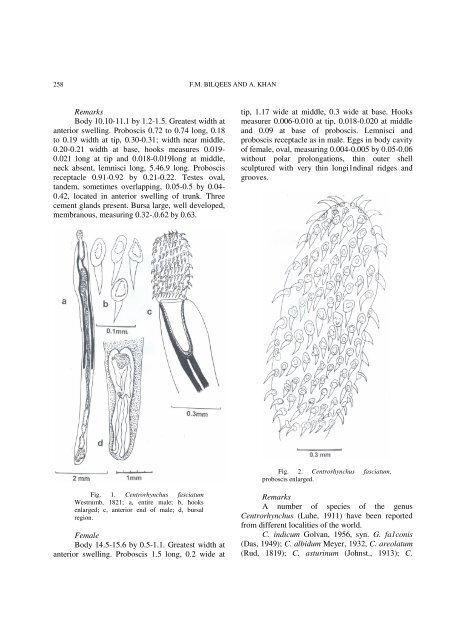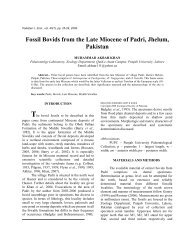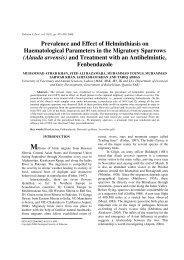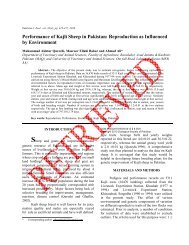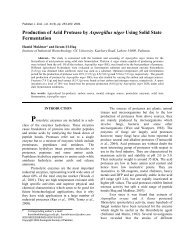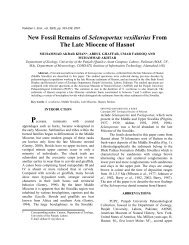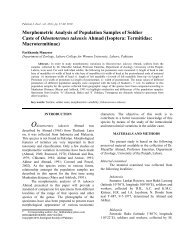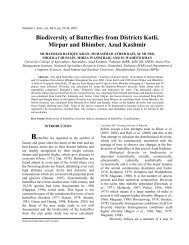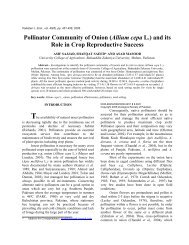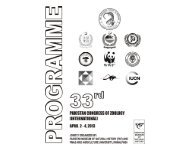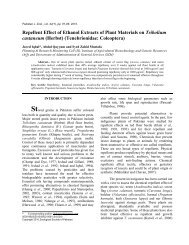Two New Helminth Parasites from Pakistan, with ... - Zsp.com.pk
Two New Helminth Parasites from Pakistan, with ... - Zsp.com.pk
Two New Helminth Parasites from Pakistan, with ... - Zsp.com.pk
Create successful ePaper yourself
Turn your PDF publications into a flip-book with our unique Google optimized e-Paper software.
258<br />
F.M. BILQEES AND A. KHAN<br />
Remarks<br />
Body 10.10-11.1 by 1.2-1.5. Greatest width at<br />
anterior swelling. Proboscis 0.72 to 0.74 long, 0.18<br />
to 0.19 width at tip, 0.30-0.31; width near middle,<br />
0.20-0.21 width at base, hooks measures 0.019-<br />
0.021 long at tip and 0.018-0.019Iong at middle,<br />
neck absent, lemnisci long, 5.46.9 long. Proboscis<br />
receptacle 0.91-0.92 by 0.21-0.22. Testes oval,<br />
tandem, sometimes overlapping, 0.05-0.5 by 0.04-<br />
0.42, located in anterior swelling of trunk. Three<br />
cement glands present. Bursa large, well developed,<br />
membranous, measuring 0.32-.0.62 by 0.63.<br />
tip, 1.17 wide at middle, 0.3 wide at base. Hooks<br />
measurer 0.006-0.010 at tip, 0.018-0.020 at middle<br />
and 0.09 at base of proboscis. Lemnisci and<br />
proboscis receptacle as in male. Eggs in body cavity<br />
of female, oval, measuring 0.004-0.005 by 0.05-0.06<br />
<strong>with</strong>out polar prolongations, thin outer shell<br />
sculptured <strong>with</strong> very thin longi1ndinal ridges and<br />
grooves.<br />
Fig. 2. Centrorhynchus fasciatum,<br />
proboscis enlarged.<br />
Fig. 1. Centrorhynchus fasciatum<br />
Westrumb, 1821; a, entire male; b, hooks<br />
enlarged; c, anterior end of male; d, bursal<br />
region.<br />
Female<br />
Body 14.5-15.6 by 0.5-1.1. Greatest width at<br />
anterior swelling. Proboscis 1.5 long, 0.2 wide at<br />
Remarks<br />
A number of species of the genus<br />
Centrorhynchus (Luhe, 1911) have been reported<br />
<strong>from</strong> different localities of the world.<br />
C. indicum Golvan, 1956, syn. G. fa1conis<br />
(Das, 1949); C. albidum Meyer, 1932, C. areolatum<br />
(Rud, 1819); C. asturinum (Johnst., 1913); C.


